We use gas fired combustion turbines or boilers and steam turbines to generate electricity. These heat engines only convert about 30% of the fuel energy to electricity. The rest of the heat is wasted.
We also use natural gas to heat our homes. A good furnace is over 90% efficient! But it seems a little wasteful to use chemical energy from natural gas to produce heat at only 21 C. Can we do better?
Combined Heat and Power (CHP) is an old concept that was developed in various industries to reduce fuel costs. Fuel is used to drive an engine and a generator to produce electricity. The waste heat from the engine is recovered and used to heat a process. You can find large CHP system for evaporating water from sugar beet juice, distilling whiskey or heating a town.
Think of a CHP unit as fancy way to provide heat, and we get electricity as a low-cost byproduct.
Combined Heat and Power is a great way to reduce carbon emissions in Alberta. By generating power and recovering waste heat, we get the most value out of our natural gas resources. CO2 emissions can be reduced by approximately 30% compared to grid-provided electricity and a dedicated furnace.
You can find small (micro) CHP units that produce enough heat (and electricity) for a home. However, these units are expensive. Payback periods for a home installation is around 15 years. This is unacceptable for most people in Alberta.
KDC is developing a unique, low cost micro CHP unit for the Alberta market. We are following the KISS strategy to reduce complexity, lose a bit of functionality, and lower the cost. The proof-of-concept unit demonstrated that a simple approach can produce power. Now we need to build a complete unit.

We will keep you posted.
